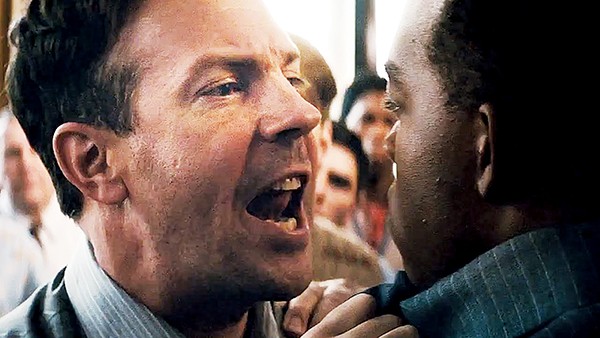The Hank Williams biopic I Saw the Light looks and feels like a movie that was scrapped halfway through shooting but cobbled together anyway, awkwardly, with many key and climactic moments left out. To patch all the disparate bits together, director Marc Abraham inserts aged, black-and-white footage of Bradley Whitford as the enormous and all-knowing head of music publisher Fred Rose, who appears on screen anytime somebody needs to explain what the hell’s going on or why anybody might care.
Instead of creating a sense of authenticity, indiscriminate use of documentary-style interviews makes the whole enterprise seem that much more insincere. One wonders if Whitford will eventually lead the cast in a rousing chorus of the “Time Warp.”

Tom Hiddleston as Hank Williams in I Saw the Light
The Hank Williams story is one part Amadeus and two parts Sid and Nancy. Here was a young, uncontrollable brat with a touch of genius whose genre-defying songs threatened a carefully maintained hierarchy in country and pop that ruffled more feathers from Nashville to New York than all the troubled hillbilly’s missed tour dates combined. There’s the obsessive, endlessly destructive marriage to his wife Audrey (Elizabeth Olsen), who was determined to become a celebrity in her own right. All of that potential drama is left on the table in favor of softer, more sympathetic characterizations, and a complete rejection of the idea that, in order for the light to matter, things need to get pretty damn dark.
I Saw the Light chooses to turn Hank Williams’ life story into an old fashioned disease-of-the-week movie, with loving shots of Cherry Jones as Hank’s ma giving Scarlet Witch some stinky side-eye.
The saddest part of all this is that Tom Hiddleston’s acting chops are considerable. Loki may be a little stiff when he’s singing and swinging, but he’s an impressive shape-shifter and a fair vocal mimic.
For all of its landscape shots, I Saw the Light has no sense of place, and even less sense of purpose. Alabama could be Shreveport, could be Nashville, it’s all the same. But what’s most fascinating about the way I Saw the Light fails, is the way it decisively treats Williams’ music — from process to performance — as a tertiary concern. Musicians like Ray Price (Von Lewis) and Faron Young (Fred Parker Jr.) are introduced to the story line but never explained, and, aside from a handful of Hiddleston performances, no attention is paid to the changing sounds of postwar country music, the people who listened to it, or the people who profited from it. The guy had some hits, but what about all of the terrible back pain he suffered? And the drinking problem! Those ill-defined mommy/wifey issues? Without the music, no amount of talking head inserts can explain why we should care.


